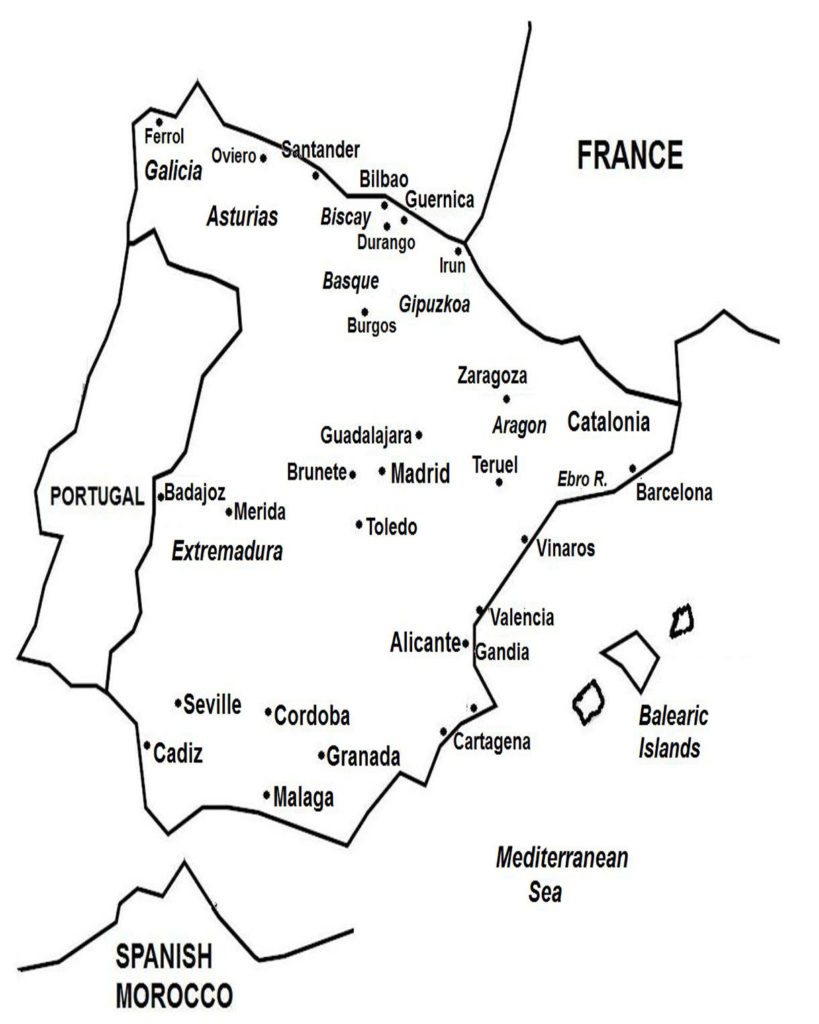On March 26, 1939, Nationalist forces advanced into central Spain, meeting no resistance as the junta had ordered Republican soldiers to raise white flags and retreat from the frontlines. On March 28, the Nationalists entered Madrid, where large crowds welcomed them as liberators. The Nationalists then continued across eastern Spain to the Mediterranean coast.
(Taken from Spanish Civil War – Wars of the 20th Century – Volume 3)
In December 1938, one month after the fighting in the Ebro ended, General Francisco Franco, leader of the Nationalist forces, was ready to advance into Catalonia, with Barcelona, the Republican government’s capital, as the ultimate objective. The Nationalists assembled a force of 300,000 soldiers, 300 tanks, 1,400 artillery pieces, and 500 planes. Meeting this were also about 300,000 Republican soldiers, but who were only poorly equipped with firearms, and supported by 40 tanks, 250 artillery pieces, and 100 planes. Across Catalonia, the Republicans’ morale among soldiers and civilians was at its lowest, and the great majority wanted an end to the war.

On January 23, 1939, the Nationalists attacked Catalonia from the west and south. After initially meeting strong resistance, the offensive broke through and advanced all across the countryside. To take the pressure from Catalonia, in early January 1939, the Republicans opened a front in Extremadura, attacking northeast of Cordoba and gaining some territory. Then, the Nationalists counter-attacked with supporting air firepower, and threw back the Republicans.
By the third week of January 1939, the Nationalists had reached the outskirts west and south of Barcelona. The Republican government, led by President Manuel Azaña and Prime Minister Negrin, evacuated from the capital and fled north to the Spanish-French border. Some 500,000 Republican soldiers and civilians joined the retreat, pursued by the Nationalist Army. Prime Minister Negrin appealed to General Franco for peace talks, but was rejected, as the Nationalist leader wanted only unconditional surrender. On January 26, Barcelona fell to the Nationalists.
In early February 1939, the retreating Republican Army and civilians entered into France (the French government had reopened the border). The refugees were gathered by French authorities and then interned in camps. After the war, some 200,000 refugees returned to Spain, while 300,000 eventually immigrated to other countries in Europe and the Americas. On February 9, 1939, Nationalist forces reached the Spanish-French border, which they closed down. By this time, Catalonia was fully under the Nationalists’ control. Three weeks later, France and Britain recognized General Franco’s government.
Prime Minister Negrin managed to fly back to Republican Spain to take over control of the remaining territories still held by the Republicans. By then, however, although the Republicans still held about 30% of Spain, the war essentially was over. Negrin established his headquarters at Alicante, where he appointed communist officers to high-ranking military positions. In Madrid, non-communist officers, concerned that the Republican government was becoming communist, launched a coup on March 5, 1939 that deposed Prime Minister Negrin. However, communist units of the Republican Army opposed the coup, leading to the outbreak of fighting between pro-communist and anti-communist forces of the Republican Army. After five days of clashes, anti-communist forces prevailed in Madrid.
After overthrowing the Republican regime, the coup leaders formed a military-civilian junta (called the National Council of Defense), which was made up of military officers, as well as socialist and anarchist leaders. After fighting in Madrid ended, the junta tried to negotiate a peace treaty with General Franco, but the talks failed. On March 26, 1939, Nationalist forces advanced into central Spain, meeting no resistance as the junta had ordered Republican soldiers to raise white flags and retreat from the frontlines.
On March 28, the Nationalists entered Madrid, where large crowds welcomed them as liberators. The Nationalist advance across eastern Spain to the Mediterranean coast also met no opposition, with Jaen, Cuenca, Albacete, and Sagunto being taken without incident. As a result of the Nationalist advance, some 50,000 Republican supporters fled to the ports of Valencia, Alicante, Cartagena, and Gandia in the hope of escaping abroad. Fewer than 5,000 of these Republicans made it out of Spain. By April 1, the Nationalists had captured the eastern coast, and thus controlled all of Spain. The war was over. About 500,000 persons lost their lives in the war; this figure includes total combat-related deaths of soldiers and civilians, and non-combat fatalities from various causes including summary executions, starvation, and diseases.
Aftermath Following the war, General Franco established a right-wing, anti-communist dictatorial government centered on the Falange Party. Socialists, communists, and anarchists, were outlawed, as were free-party politics. Political enemies were killed or jailed; perhaps as many as 200,000 lost their lives in prison or through executions. The political autonomies of Basque and Catalonia were voided. These regions’ culture, language, and identity were suppressed, and a single Spanish national identity was enforced.
After World War II ended, Spain became politically and economically isolated from most of the international community because of General Franco’s affiliation with the defeated fascist regimes of Germany and Italy. Then with increasing tensions in the Cold War between the United States and Soviet Union, the U.S. government became drawn to Spain’s staunchly anti-communist stance and strategic location at the western end of the Mediterranean Sea.
In September 1953, Spain and the United States entered into a defense agreement known as the Pact of Madrid, where the U.S. government infused large amounts of military assistance to Spain’s defense. As a result, Spain’s diplomatic isolation ended, and the country was admitted to the United Nations in 1955.
Its economy devastated by the civil war, Spain experienced phenomenal economic growth during the period from 1959 to 1974 (known as the “Spanish Miracle”) when the government passed reforms that opened up the financial and investment sectors. Spain’s totalitarian regime ended with General Franco’s death in 1975; thereafter, the country transitioned to a democratic parliamentary monarchy which it is today.
